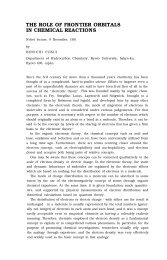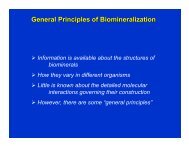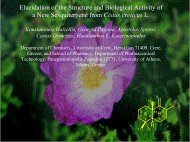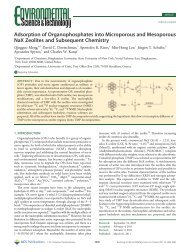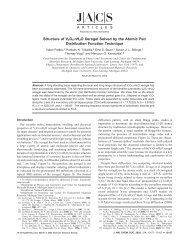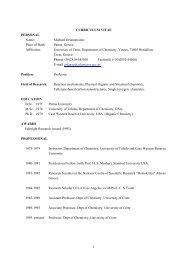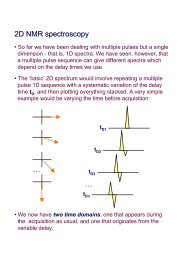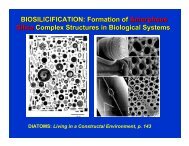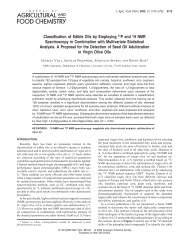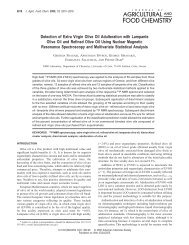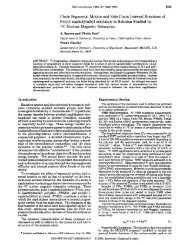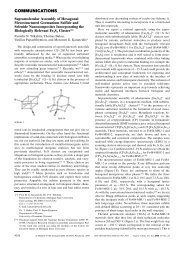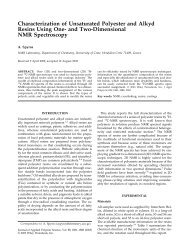Humic Acids: Marvelous Products of Soil Chemistry - Department of ...
Humic Acids: Marvelous Products of Soil Chemistry - Department of ...
Humic Acids: Marvelous Products of Soil Chemistry - Department of ...
Create successful ePaper yourself
Turn your PDF publications into a flip-book with our unique Google optimized e-Paper software.
<strong>Products</strong> <strong>of</strong> <strong>Chemistry</strong><br />
<strong>Humic</strong> <strong>Acids</strong>: <strong>Marvelous</strong> <strong>Products</strong> <strong>of</strong> <strong>Soil</strong> <strong>Chemistry</strong><br />
What soil component is a redox reagent and a pH buffer,<br />
retains water, binds metal ions, sorbs organic solutes, photosensitizes<br />
soil reactions, stimulates plant growth, and biotransforms<br />
toxic pollutants? The answer is the brown-to-black<br />
soil biomaterials called humic acids (HAs), which are essential<br />
components <strong>of</strong> healthy, productive soils. The name humic<br />
acid is derived from its earthly source, humus.<br />
A soil’s ability to retain water and stimulate plant growth<br />
depends on the soil organic matter (SOM) and especially on<br />
its humic substances (HSs) fraction. Arable soils contain up<br />
to 10% SOM, and HSs typically account for 80% <strong>of</strong> the SOM<br />
(1–4). Figure 1 shows the major precursors <strong>of</strong> soil organic<br />
matter (5). Dead leaves, a major soil input, consist <strong>of</strong> 50–<br />
60% cellulose, 15–20% lignins, and 15–20% lipids (6 ). <strong>Soil</strong><br />
chemical and microbiological oxidation <strong>of</strong> dead animals and<br />
plants (humification) initially is exothermic, but then becomes<br />
slow synthesis and degradation <strong>of</strong> HSs (7). Degradation <strong>of</strong> HSs<br />
ultimately leads to coal (mostly aromatic), crude oil (mostly<br />
aliphatic), and carbon dioxide. The aromatization <strong>of</strong> aliphatic<br />
soil components or HSs to yield coal is an oxidation (dehydrogenation)<br />
process. The CO2 product <strong>of</strong> HS respiration<br />
completes the carbon cycle, prevents the earth from being<br />
covered with HS soup, and reminds us that HSs are longlived<br />
but eventually transient on geological time scales.<br />
<strong>Soil</strong> has an important role in the air–soil–water cycle. HAs<br />
are among the most active components <strong>of</strong> soil. Consider just<br />
a few <strong>of</strong> the factors that involve humic materials in that cycle.<br />
HSs contain more carbon than all living things.<br />
<strong>Soil</strong> respiration contributes much more to global CO2 levels than fossil fuel combustion for heating and transportation<br />
(8, 9).<br />
Solid HSs act as pH buffers, metal binders, solute sorbents,<br />
and redox catalysts, and they are photosensitizers. No<br />
other natural materials have so many functions in so<br />
many different places (1–5, 10, 11).<br />
HSs are more versatile than any other synthetic or natural<br />
material and they are biodegradable and non-allergenic if<br />
free from harmful metals, xenobiotics and microorganisms.<br />
The deserts are growing, populations are exploding, and<br />
huge amounts <strong>of</strong> soil and humic substances wash away<br />
every year by erosion (12). HSs lost from soils need to<br />
be replenished.<br />
Long-term intensive farming depletes SOM (13). Solutions<br />
to SOM loss include promoting organic farming,<br />
replacing incinerators with waste composting, and<br />
seeking alternative natural sources <strong>of</strong> HSs, the pivotal<br />
components <strong>of</strong> the air–soil–water system.<br />
<strong>Chemistry</strong> for Everyone<br />
Ge<strong>of</strong>frey Davies* and Elham A. Ghabbour<br />
Barnett Institute and the <strong>Chemistry</strong> <strong>Department</strong>, Northeastern University, Boston, MA 02115; *g.davies@neu.edu<br />
Cornelius Steelink<br />
<strong>Chemistry</strong> <strong>Department</strong>, University <strong>of</strong> Arizona, Tucson, AZ 85721<br />
Small wonder that this class <strong>of</strong> natural substances has been<br />
the object <strong>of</strong> so much study over the last 100 years. Scientific<br />
interest in humic substances is continually expanding, despite<br />
inherent natural obstacles. For example, it is important to<br />
know which components <strong>of</strong> HSs are responsible for some <strong>of</strong><br />
the major processes in soils and waters, and the proportions<br />
<strong>of</strong> these components in a humic source. For meaningful structural<br />
studies, it is desirable to deal with pure substances. However,<br />
HSs are gross mixtures whose separation into discrete<br />
substances is a continuing challenge.<br />
Isolation and Classification <strong>of</strong> HSs<br />
edited by<br />
George B. Kauffman<br />
California State University<br />
Fresno, CA 93740<br />
Figure 2 summarizes a thorough HS isolation protocol<br />
that depends on HSs’ properties as acids (14, 15). Dry soil<br />
Soxhlet extraction with benzene–methanol removes trapped<br />
lipids, nucleic acids, polysaccharides, proteins, and smaller<br />
molecules. The soil then is treated with dilute HCl and<br />
washed with water. The residue is repeatedly extracted with<br />
dilute NaOH until the supernatants no longer deposit a<br />
proteins and<br />
amino acids<br />
lignin and<br />
lignin like<br />
Figure 1. Typical soil inputs.<br />
air dried<br />
solid sample<br />
supernatant<br />
HUMIC ACIDS<br />
benzenemethanol<br />
2:1(v/v)<br />
supernatant<br />
HCl<br />
pH = 1<br />
leaf polyphenols<br />
cellulose and other<br />
polysaccharides<br />
JChemEd.chem.wisc.edu • Vol. 78 No. 12 December 2001 • Journal <strong>of</strong> Chemical Education 1609<br />
gel<br />
lipids<br />
Figure 2. HA extraction scheme.<br />
residue<br />
HCl/HF, H 2O,<br />
dialyze, dry<br />
0.1M<br />
NaOH<br />
wash with<br />
0.1M HCl<br />
wash with<br />
H2O residue<br />
residue<br />
HA
<strong>Chemistry</strong> for Everyone<br />
brown hydrogel when the pH is reduced to 1 with HCl. The<br />
washed and dialyzed gel is defined as a humic acid (HA) and<br />
contains up to 98% water. It can be vacuum-oven-, freeze-,<br />
or supercritical-fluid-CO 2-dried to give solids with different<br />
densities, surface areas, and morphologies (16 ). The supernatants<br />
at pH 1 contain the soluble HS subclass called fulvic<br />
acids (FAs), which tend to be more aliphatic and have a higher<br />
functional group density than HAs. A third HS subclass called<br />
humins (HUs) probably are HA–clay–mineral composites<br />
(17). HAs stick firmly to clays and other minerals, which<br />
prevents them from being washed from soils. They dominate<br />
HSs and SOM and are the focus <strong>of</strong> what follows.<br />
<strong>Humic</strong> Acid Characteristics<br />
Table 1 indicates that HAs are carbon-rich materials with<br />
characteristic and fairly constant 3 mmol/g HA carboxylic<br />
acid contents but variable phenol contents and total acidity.<br />
Atomic ratios indicate the humification status: the H/C ratio<br />
<strong>of</strong> an HS sample can range from 2 (aliphatic, as in a lipid) to<br />
Figure 4. a: β-O-4 lignin building blocks (31).<br />
b: Proposed “TNB” HA building block (32).<br />
c: Hollow elliptical helix obtained by linking<br />
lowest-energy TNB HA building blocks (32).<br />
d: Proposed 3-dimensional HA molecule. Note<br />
the predicted cavities for solute and water<br />
binding (reproduced by permission from ref<br />
34).<br />
(28). Highly aromatic HAs are more compact. At higher pH,<br />
time-dependent disaggregation and molecular stretching on<br />
dissociation <strong>of</strong> acidic groups decreases D owing to negative<br />
charge repulsion (29).<br />
HA Formation and Structures<br />
As revealed by their 13 C NMR spectra, HAs isolated from<br />
plants tend to be more aliphatic than those from soils. This<br />
suggests that HA formation from plants is completed in the<br />
soil (14). Humification is an oxidative process that includes<br />
aromatization and condensation reactions in the soil environment.<br />
Major pathways <strong>of</strong> HA synthesis in soils involve<br />
enzymatic and abiotically catalyzed free radical and condensation<br />
reactions, phenolic oxidative coupling, demethylation,<br />
and functional group oxidation <strong>of</strong> plant polyphenols, which<br />
occurs in leaves primarily in the fall (6, 30). Humification<br />
probably is catalyzed by microorganisms on clay and mineral<br />
surfaces, where life may have begun (2).<br />
The HA products are heterogeneous in three respects.<br />
First, they are made from different feedstocks. Second, they<br />
may be contaminated with sorbed lipids, nucleic acids, polysaccharides,<br />
proteins, steroids, clays, minerals, and metals. The<br />
pre-extraction with benzene–methanol in Figure 2 lessens this<br />
possibility. Third, they contain functionalized aliphatic–<br />
aromatic backbones that may be neutral, acidic, or basic and<br />
have low or high molecular weight.<br />
Consistent analytical and other properties encourage<br />
modeling <strong>of</strong> HAs. The first kind <strong>of</strong> model envisions the<br />
“average” HA building block and the second models the<br />
whole SOM. One HA building block (Fig. 4a [31]) comes<br />
from conversion <strong>of</strong> lignins and tannins; the other pathway is<br />
biosynthesis from amino acids (32). Lignin also is biosynthesized<br />
from amino acids. Actually, the so-called Temple–<br />
Northeastern–Birmingham (TNB) building block (Fig. 4b<br />
[14, 18, 32]) can be generated in known reactions from<br />
a b<br />
c<br />
<strong>Chemistry</strong> for Everyone<br />
known lignin components as suggested in Figure 5 (33). The<br />
proposed building blocks all have chiral centers and link<br />
together to give hollow helical structures that normally are<br />
filled with water (Fig. 4c). Random-coil HA behavior was<br />
deduced from frictional ratios in ultracentrifugation data (23).<br />
Thus, the helical model accounts for water retention by HAs<br />
in terms <strong>of</strong> their hollow centers and many hydrophilic functional<br />
groups on the outside <strong>of</strong> the secondary structure.<br />
The whole SOM model in Figure 4d (34) consists <strong>of</strong><br />
substituted benzene rings linked by long aliphatic chains in<br />
a molecule with M w ≈ 5 kDa. The structure has cavities large<br />
enough to accommodate peptides, small polysaccharides,<br />
water, and other solutes. The building blocks and wholemolecule<br />
HA models are mass fractals because <strong>of</strong> their “holes”.<br />
Whatever their structures, the fact is that HAs are excellent<br />
sorbents because they are hydrophilic, hydrophobic, and<br />
functionalized. This qualifies them as amphiphiles (6 ) that<br />
lower the surface tension <strong>of</strong> water and form micelles that can<br />
sequester hydrophobic molecules such as pyrene, adsorb more<br />
polar compounds, and bind metals. Another great gift <strong>of</strong> their<br />
versatility is that solid HAs behave as free-energy buffers (35).<br />
HO<br />
oxidation<br />
JChemEd.chem.wisc.edu • Vol. 78 No. 12 December 2001 • Journal <strong>of</strong> Chemical Education 1611<br />
O<br />
d<br />
oxidation and<br />
demethylation<br />
OCH3 HO HO OH<br />
oxidative<br />
demethylation<br />
and ring cleavage<br />
OH<br />
OCH 3<br />
Figure 5. Conversion <strong>of</strong> a lignin unit toward a TNB HA building block.<br />
HO<br />
OH<br />
oxidation<br />
oxidative<br />
demethylation<br />
OCH 3<br />
OH
<strong>Chemistry</strong> for Everyone<br />
Supramolecular models <strong>of</strong> HS structures are being put<br />
forward (21, 25) and the supramolecular chemistry <strong>of</strong> HSs is a<br />
new and exciting field (25). Instead <strong>of</strong> single monomeric<br />
species, HSs are being described as micelles, colloids, aggregates,<br />
vesicles, fractals, clathrates, and surfactants. Macroscopic surface<br />
areas are being measured and their morphological features<br />
described. Advanced computer modeling is predicting shapes,<br />
folding patterns, and metal chelation sites (32).<br />
Macromolecular architecture and surface features can be<br />
measured by atomic force microscopy (AFM) and other<br />
microprobe techniques (20, 36 ). The shapes and properties<br />
<strong>of</strong> HSs can be dramatically altered in response to changes in<br />
pH or ionic strength and exposure to minerals (20, 36 ). The<br />
actual behavior <strong>of</strong> HSs in natural soil and water environments<br />
is a function <strong>of</strong> the molecular structure, which has important<br />
implications for contaminant mobility, aggregation, and<br />
adhesion to clay surfaces.<br />
<strong>Humic</strong> Substances in Drinking Water<br />
There is an old saying in the Wild West: “Whiskey is<br />
for drinking, but water is for fighting.” Battles over water<br />
rights are not only a characteristic <strong>of</strong> the western USA but<br />
also a worldwide phenomenon. In recent years, however, the<br />
battle lines have focused on drinking water quality as well as<br />
ownership.<br />
Surface waters contain a range <strong>of</strong> inorganic salts and<br />
organic solutes. These waters are required to be treated and<br />
disinfected by the Environmental Protection Agency (EPA)<br />
as well as local governmental agencies, thus adding more<br />
ingredients to the water. Odor and taste properties have been<br />
affected as a result. These treatments have caused a change<br />
in the public perception <strong>of</strong> municipal tap water. In the past<br />
10 years there has been a sharp increase in the consumption<br />
<strong>of</strong> bottled water as a result <strong>of</strong> the public suspicion <strong>of</strong> tap water.<br />
Possibly the most influential group <strong>of</strong> organic solutes in<br />
surface waters are HSs, specifically HAs and FAs. Although<br />
benign and even therapeutic in themselves, these humates<br />
react with disinfectants to produce disinfection by-products<br />
(DBPs), which are toxic and regulated by the EPA. The most<br />
common disinfectant in municipal treatment plants is chlorine.<br />
It reacts with HSs to produce chlor<strong>of</strong>orm and other<br />
hal<strong>of</strong>orms, which are classified by the EPA as trihalomethanes<br />
(THMs). This reaction, the hal<strong>of</strong>orm reaction (eq 1), is a<br />
common topic in sophomore organic chemistry.<br />
OH + RCOCH 3 + 3Cl 2 → RCOO + CHCl 3 + 3HCl (1)<br />
The yield <strong>of</strong> chlor<strong>of</strong>orm strongly depends on the apparent<br />
molecular weight <strong>of</strong> the humic acid species (37). Many other<br />
halogenated aromatic and aliphatic products (DBPs) are also<br />
produced, but all <strong>of</strong> them in much smaller quantities than the<br />
THMs. The THMs are potential carcinogens: approximately<br />
10,000 people a year in the USA contract bladder or colon<br />
cancer from drinking chlorinated waters (38). At present,<br />
municipal water suppliers must limit the concentration <strong>of</strong><br />
THMs to less than 80 µg/kg (80 µg/L, or ppb for dilute<br />
aqueous solutions) in the potable water distribution system.<br />
Faced with the EPA restrictions, municipal water companies<br />
have used technologies to reduce the production <strong>of</strong><br />
THMs. Two methods commonly used in water treatment<br />
plants are (i) alternate disinfectants to chlorine, such as ozone,<br />
chloramine, and chlorine dioxide, and (ii) removal <strong>of</strong> humic<br />
acids from the source (raw) water.<br />
The first method is most widely used. The second is<br />
more expensive; it employs filters such as activated charcoal,<br />
anthracite, or treated sand. None <strong>of</strong> the filtration systems<br />
remove all the humic substances, but they can reduce chlor<strong>of</strong>orm<br />
levels to meet EPA guidelines.<br />
One other method <strong>of</strong> removing humic acid from surface<br />
waters relies on nature itself. It is known as soil aquifer treatment<br />
(SAT) and utilizes soil as the filter. By percolating raw<br />
water into large basins, water managers can recharge the aquifer<br />
while removing much <strong>of</strong> the humic acid (39). The treated,<br />
stored water can then be pumped to the municipal water<br />
delivery system when needed.<br />
Redox Properties <strong>of</strong> <strong>Soil</strong> <strong>Humic</strong> <strong>Acids</strong><br />
<strong>Soil</strong> humic acids are redox polymers. Although they can<br />
act as oxidants and reductants, their most common behavior<br />
under natural conditions is as reducing agents. The standard<br />
reduction potential <strong>of</strong> a typical soil HA is 700 mV (40). In<br />
other words, humic acids are capable <strong>of</strong> reducing Fe(III),<br />
Sn(IV), V(V), and Cr(VI). In return, certain functional groups<br />
in HA are oxidized. Some possible candidates are catechol<br />
moieties (oxidized to quinones), phenolic groups (to free<br />
radicals or quinhydrones), aldehydes (to carboxylic acids),<br />
and alcohols (to aldehydes or carboxylic acids).<br />
Oxidation and reduction <strong>of</strong> HAs is a reversible, repeatable<br />
process (41) that takes place in one-electron steps. The intermediate<br />
species is a semiquinone free radical. The phenolic<br />
and quinone groups in the HA polymer are the functional<br />
groups responsible for this redox behavior (5, 19).<br />
Recently, a number <strong>of</strong> commercial products derived from<br />
HAs have capitalized on these remarkable reducing properties<br />
(42). <strong>Humic</strong> acids derived from natural sources are crosslinked<br />
with polymers to make them insoluble in water. These<br />
products are then able to detoxify soils and surface waters<br />
contaminated with toxic organic and inorganic chemicals. Some<br />
metals are reduced from toxic valence states to a nontoxic<br />
state—for example, Cr(VI) to Cr(III). More striking is the<br />
reductive cleavage <strong>of</strong> halogenated hydrocarbons. Substances like<br />
trichloroethylene (TCE), a very common pollutant in soils<br />
and ground water, are dehydrohalogenated to ethylene and<br />
HCl (43, 44). This reduction corresponds to the reduction<br />
<strong>of</strong> TCE by elemental iron! A very bright future is envisioned<br />
for the detoxification applications <strong>of</strong> humic substances.<br />
Solid HAs as Sorbents and Metal Binders<br />
Solid humic acids have large sorption capacities for hydrophilic<br />
and hydrophobic solutes. 13 C NMR spectra show<br />
that soil HAs consist <strong>of</strong> aliphatic and aromatic backbones<br />
with the aromatic fraction rarely exceeding 50% <strong>of</strong> the total<br />
carbon (45, 46 ). Functional groups such as –COOH give<br />
hydrophilic character to HAs. Aliphatic chains give HAs<br />
flexibility, while the aromatic units are rigid. This is why HAs<br />
can interact with so many different solutes.<br />
Sorption <strong>of</strong> hydrophobic organic compounds occurs by<br />
partitioning/dissolution into an amorphous phase (47) or<br />
interaction with rigid units such as stacked aromatic rings<br />
(48). One piece <strong>of</strong> evidence for specific interactions is to have<br />
1612 Journal <strong>of</strong> Chemical Education • Vol. 78 No. 12 December 2001 • JChemEd.chem.wisc.edu
N < 1 in the Freundlich equation (eq 2)<br />
A = K fc N (2)<br />
where A is the mass <strong>of</strong> sorbed solute per unit mass <strong>of</strong> HA, K f<br />
is the sorption coefficient, and c is the equilibrium solute concentration.<br />
For solute distribution between water and a structureless<br />
“liquid” HA phase, N would be 1. Another clue<br />
comes from competition between solutes for adsorption (48).<br />
Data for adsorption <strong>of</strong> hydrophilic solutes such as uracil fit<br />
the Langmuir equation (eq 3) for specific adsorption in<br />
sequential steps A, B, and C. Here, K is the equilibrium<br />
constant and v is the site capacity. As expected, adsorption<br />
<strong>of</strong> hydrophilic solutes is competitive. Physical adsorption<br />
results in higher solute desorption rates than for chemically<br />
sorbed solutes (e.g., by condensation <strong>of</strong> amines with HA<br />
carboxylic acid groups) (34).<br />
A = Kvc/(1 + Kc) (3)<br />
Solid HAs have an unusual ability to “create” additional<br />
adsorption sites by disaggregation as a result <strong>of</strong> primary organic<br />
solute adsorption. Linear correlation <strong>of</strong> the thermodynamic<br />
adsorption parameters ∆H i and ∆S i for every solute and adsorption<br />
step indicates that HAs selectively bind solutes with<br />
small, fairly constant, negative free-energy changes. That is,<br />
they are free-energy buffers, which is made possible by compensating<br />
enthalpy and entropy changes for adsorption. Water<br />
and bound metals evidently play major roles in HA–solute<br />
interactions and in HA aggregation/disaggregation (34, 49).<br />
<strong>Humic</strong> acids have higher metal-binding capacities than<br />
most commercial ion exchangers and they selectively bind,<br />
store, and release metals. <strong>Humic</strong> acids can be used in soil<br />
remediation to trap contaminants. They also can transport<br />
metals to other sites. Metals principally are bound by HA<br />
carboxylate groups (50), which means that HAs act at least<br />
in part as weak-acid cation exchangers. Bound metals and<br />
minerals reduce HA flexibility and cause HA aggregation (49),<br />
or they block the sorption sites and reduce the sorption<br />
capacity (51). HAs’ molecular flexibility enables them to wrap<br />
around a metal center. Metals also can bridge functional<br />
groups on different HA molecules (34, 50). X-ray absorption<br />
fine-structure spectroscopy (XAFS) and X-ray absorption nearedge<br />
spectroscopy (XANES) are helping us to understand how<br />
HAs bind metals. They identify the metals and their oxidation<br />
states as well as their binding sites (14, 52, 53).<br />
Other HA Sources<br />
Humus and potting soil sales are big business, but it makes<br />
little sense to replenish large amounts <strong>of</strong> desert with soil from<br />
another location. Polyphenols and lignins have only part <strong>of</strong><br />
soil HAs’ attributes because they are more aromatic and need<br />
to be modified, for example as in Figure 5. One solution to<br />
soil shortages is accelerated large-scale composting, which is<br />
<strong>of</strong> worldwide interest (7). Plants that contain HAs are good<br />
composting feedstock. Another HA source is s<strong>of</strong>t brown coals<br />
and Leonardite, which contain up to 80% extractable HAs<br />
that resemble soil HAs but are more aromatic (46 ). These<br />
economical coal-derived HAs are useful for soil and water<br />
remediation. They promote plant growth by improving the<br />
availability <strong>of</strong> Fe, Zn, and other micronutrients (54, 55).<br />
<strong>Chemistry</strong> for Everyone<br />
Conclusions<br />
<strong>Humic</strong> acids are essential and remarkable products <strong>of</strong> soil<br />
chemistry. Current HA models help to explain their origin<br />
and behavior as flexible, aliphatic-aromatic, and highly<br />
functionalized molecules. Composting and economical HA<br />
extraction from coal will help to combat water and soil<br />
pollution, fight soil erosion, and lessen our dependence on<br />
chemical fertilizers.<br />
Literature Cited<br />
1. <strong>Humic</strong> Substances in <strong>Soil</strong> and Crop Science: Selected Readings;<br />
MacCarthy, P.; Clapp, C. E.; Malcolm, R. L.; Bloom, P. R.,<br />
Eds.; American Society <strong>of</strong> Agronomy: Madison, WI, 1990.<br />
2. Stevenson, F. J. Humus <strong>Chemistry</strong>, 2nd ed.; Wiley: New York,<br />
1994.<br />
3. Sparks, D. L. Environmental <strong>Soil</strong> <strong>Chemistry</strong>; Academic Press:<br />
San Diego, 1995.<br />
4. Steelink, C. J. Chem. Educ. 1977, 54, 599–603.<br />
5. Steelink, C. J. Chem. Educ. 1963, 40, 379–384.<br />
6. Wershaw, R. L. <strong>Soil</strong> Sci. 1999, 164, 803–813.<br />
7. The Science <strong>of</strong> Composting: Parts 1 and 2; de Bertoldi, M.;<br />
Sequi, P.; Lemmes, B.; Papi, T., Eds.; Blackie Academic and<br />
Pr<strong>of</strong>essional: Glasgow, 1996.<br />
8. Hayes, M. H. B. In <strong>Humic</strong> Substances: Structures, Properties<br />
and Uses; Davies, G.; Ghabbour, E. A., Eds.; Royal Society <strong>of</strong><br />
<strong>Chemistry</strong>: Cambridge, 1998; pp 1-27.<br />
9. Jenkinson, D. S.; Adams, D. E.; Wild, A. Nature 1991, 351,<br />
304–306.<br />
10. <strong>Humic</strong> Substances: Structures, Properties and Uses; Davies, G.;<br />
Ghabbour, E. A., Eds.; Royal Society <strong>of</strong> <strong>Chemistry</strong>: Cambridge,<br />
1998.<br />
11. Understanding <strong>Humic</strong> Substances: Advanced Methods, Properties<br />
and Applications; Ghabbour, E. A.; Davies, G., Eds.; Royal<br />
Society <strong>of</strong> <strong>Chemistry</strong>: Cambridge, 1999.<br />
12. Wild, A. <strong>Soil</strong>s and the Environment: An Introduction; Cambridge<br />
University Press: New York, 1993; Chapter 12, pp 233–<br />
248.<br />
13. Schulten, H.-R.; Monreal, C. M.; Schnitzer, M.<br />
Naturwissenschaften 1995, 82, 42–44.<br />
14. Davies, G.; Fataftah, A.; Cherkasskiy, A.; Ghabbour, E. A.;<br />
Radwan, A.; Jansen, A. S.; Kolla, S.; Paciolla, M. D.; Sein, L.<br />
T. Jr.; Buermann, W.; Balasubramanian, M.; Budnick, J.; Xing,<br />
B. J. Chem. Soc. Dalton Trans. 1997, 4047–4060.<br />
15. Pierce, R. H. Jr.; Felbeck, G. T. Jr. Proc. Int. Mtg. <strong>Humic</strong> Substances<br />
Niewersluis 1972, 217–232.<br />
16. Willey, R. J.; Radwan, A.; Vozzella, M. E.; Fataftah, A.;<br />
Ghabbour, E. A.; Davies, G. J. Non-Cryst. Solids 1998, 225,<br />
30–35.<br />
17. Rice, J. A.; MacCarthy, P. Environ. Sci. Technol. 1991, 24,<br />
1875–1877.<br />
18. Paciolla, M. D.; Kolla, S.; Sein, L. T. Jr.; Varnum, J. M.;<br />
Malfara, D. L.; Davies, G.; Ghabbour, E. A.; Jansen, S. A. In<br />
<strong>Humic</strong> Substances: Structures, Properties and Uses; op. cit., pp<br />
203–214.<br />
19. Scott, D. T.; McKnight, D. M.; Blunt-Harris, E. L.; Kolesar, S.<br />
E.; Lovley, D. R. Environ. Sci. Technol. 1998, 32, 2984–2989.<br />
20. Myneni, S. C. B.; Brown, J. T.; Martinez, G. A.; Meyer-Llse,<br />
W. Science 1999, 286, 1335–1337.<br />
21. Haberhauer, G.; Bednar, W.; Gerzabeck, M. H.; Rosenberg,<br />
E. In <strong>Humic</strong> Substances: Versatile Components <strong>of</strong> Plants, <strong>Soil</strong>s<br />
JChemEd.chem.wisc.edu • Vol. 78 No. 12 December 2001 • Journal <strong>of</strong> Chemical Education 1613
<strong>Chemistry</strong> for Everyone<br />
and Waters, Ghabbour, E. A.; Davies, G. Eds.; Royal Society<br />
<strong>of</strong> <strong>Chemistry</strong>: Cambridge, 2000; pp 143–151.<br />
22. <strong>Humic</strong> Substances: Versatile Components <strong>of</strong> Plants, <strong>Soil</strong>s and<br />
Waters; Ghabbour, E. A.; Davies, G. Eds.; Royal Society <strong>of</strong><br />
<strong>Chemistry</strong>: Cambridge, 2000.<br />
23. Swift, R. S. <strong>Soil</strong> Sci. 1999, 164, 790–802.<br />
24. Kohl, S. D.; Toscano, P. J.; Hou, W.; Rice, J. A. Environ. Sci.<br />
Technol. 2000, 34, 204–210.<br />
25. Conte, P.; Piccolo, A. Environ. Sci. Technol. 1999, 33, 1682–<br />
1690.<br />
26. Maurice, P.; Namjesnik-Dejanovic, K.; Lower, S.; Pullin, M.<br />
In Water-Rock Interaction; Arehart, G. B.; Hulston, J. R., Eds.;<br />
Balkema: Rotterdam, 1998; pp 109–113.<br />
27. Amarasiriwardena, D.; Siripinyanond, A.; Barnes, R. M. In<br />
<strong>Humic</strong> Substances: Versatile Components <strong>of</strong> Plants, <strong>Soil</strong>s and<br />
Waters; op. cit., pp 215–226.<br />
28. Tombácz, E.; Rice, J. A.; Ren, S. Z. In The Role <strong>of</strong> <strong>Humic</strong> Substances<br />
in the Ecosystems and in Environmental Protection;<br />
Drozd, J.; Gonet, S. S.; Senesi, N.; Weber, J., Eds.; Polish Society<br />
<strong>of</strong> <strong>Humic</strong> Substances: Wroclaw, 1998; pp 43–50.<br />
29. Senesi, N. <strong>Soil</strong> Sci. 1999, 164, 841–856.<br />
30. Wershaw, R. L.; Leenheer, J. A.; Kennedy, K. R. In <strong>Humic</strong><br />
Substances: Structures, Properties and Uses; op. cit., pp 19–30<br />
and references therein.<br />
31. Shevchenko, S. M.; Bailey, G. W. J. Mol. Struct. (Theochem)<br />
1998, 422, 259.<br />
32. Sein, L. T. Jr.; Varnum, J. M.; Jansen, S. A. Environ. Sci.<br />
Technol. 1999, 33, 546.<br />
33. Young, M.; Steelink, C. Phytochemistry 1973, 12, 2851–2862.<br />
34. Schulten, H. R.; Schnitzer, M. Naturwissenschaften 1995, 82,<br />
487–498.<br />
35. Davies, G.; Ghabbour, E. A.; Khairy, A. H.; Ibrahim, H. Z.<br />
J. Phys. Chem. 1997, 101B, 3228–3239.<br />
36. Liu, C.; Huang, P. M. In Understanding <strong>Humic</strong> Substances: Advanced<br />
Methods, Properties and Applications; op. cit., pp 87–<br />
99.<br />
37. Collins, R.; Amy, G.; Steelink, C. Environ. Sci. Technol. 1986,<br />
20, 1028–1032.<br />
38. Morris, R. D. Am. J. Public Health 1992, 82, 955–963.<br />
39. Mikita, M. A.; Lo, S.; Thorn, K.; Hobson, J.; Steelink, C. In<br />
Hydrology and Water Resources in Arizona and the Southwest;<br />
Proceedings <strong>of</strong> the 1981 Meetings <strong>of</strong> the Arizona Section,<br />
American Water Resources Association, and the Hydrology<br />
Section, Arizona–Nevada Academy <strong>of</strong> Science; University <strong>of</strong><br />
Arizona, Tucson, May 1–2, 1981; Vol. 11, pp 161–168.<br />
40. Matthiessen, A. In <strong>Humic</strong> Substances in the Global Environment<br />
and Implications for Human Mealth; Senesi, N.; Miano,<br />
T. M., Eds.; Elsevier: New York, 1994; pp 187–192.<br />
41. Senesi, N.; Steelink, C. In <strong>Humic</strong> Substances II: In Search <strong>of</strong><br />
Structure; Hayes, M. B. H.; MacCarthy, P.; Malcolm, R. L.;<br />
Swift, R. S., Eds.; Wiley: New York, 1989, p 374.<br />
42. Sanjay, H. G.; Srivastava, K. C.; Walia, D. S. Adsorbent; U.S.<br />
Patent 5, 906, 960, 1999.<br />
43. Sanjay, H. G.; Fataftah, A. K; Walia, D. S.; Srivastava, K. C.<br />
In Understanding <strong>Humic</strong> Substances: Advanced Methods, Properties<br />
and Applications; op. cit., pp 241–254.<br />
44. Sanjay, H. G.; Fataftah, A. K; Walia, D. S. In <strong>Humic</strong> Substances:<br />
Versatile Components <strong>of</strong> Plants, <strong>Soil</strong>s and Waters; op. cit.,<br />
pp 309–319.<br />
45. Schulten, H. R.; Schnitzer, M. J. Plant Nutr. <strong>Soil</strong> Sci. 2000,<br />
163, 125–126.<br />
46. Xing, B.; Mao, J.; Hu, W. -G.; Schmidt-Rohr, K.; Davies, G.;<br />
Ghabbour, E. A. In <strong>Humic</strong> Substances: Structures, Properties and<br />
Uses; op. cit., pp 49–63.<br />
47. Poerschmann, J.; Kopinke, F.-D.; Plugge, J.; Georgi, A. Ibid.,<br />
pp 223–240.<br />
48. Xing, B.; Pignatello, J. J.; Gigliotti, B. Environ. Sci. Technol.<br />
1996, 30, 2432–2442.<br />
49. Engebretson, R. R.; von Wandruszka, R. Environ. Sci. Technol.<br />
1998, 32, 488–493.<br />
50. Senesi, N. In Transactions <strong>of</strong> the 15th World Congress <strong>of</strong> <strong>Soil</strong><br />
Science; International Society <strong>of</strong> <strong>Soil</strong> Science: Wageningen,<br />
Netherlands, 1994; Vol. 3a, pp 384–402.<br />
51. Ghabbour, E. A.; Davies, G.; Dunfee, R. L.; Smith, N. A.;<br />
Vozzella, M. E. Can. J. <strong>Soil</strong> Sci. 2001, 81, 331–336.<br />
52. Korshin, G. V.; Frenkel, A. I.; Stern, E. A. Environ. Sci. Technol.<br />
1998, 32, 2699–2705.<br />
53. Xia, K.; Bleam, W. F.; Helmke, P. A. Geochim. Cosmochim.<br />
Acta 1997, 61, 2223–2235 and references therein.<br />
54. Chen, Y.; Aviad, T. In <strong>Humic</strong> Substances in <strong>Soil</strong> and Crop Science:<br />
Selected Readings; MacCarthy, P.; Clapp, C. E.; Malcolm,<br />
R. L.; Bloom, P. R., Eds.; American Society <strong>of</strong> Agronomy:<br />
Madison, WI, 1990; pp 161–186.<br />
55. Future Prospects for <strong>Soil</strong> <strong>Chemistry</strong>; Huang, P. M.; Sparks, D.<br />
L.; Boyd, S. A., Eds.; <strong>Soil</strong> Science Society <strong>of</strong> America: Madison,<br />
WI, 1998.<br />
1614 Journal <strong>of</strong> Chemical Education • Vol. 78 No. 12 December 2001 • JChemEd.chem.wisc.edu




